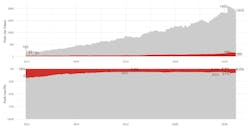In a new blog rounding up customer internet usage during COVID-19 and the response of cable broadband services, Cable Labs' director of technology policy, Mark Walker, recounts how network monitoring provider OpenVault recently revealed just how much home internet usage has jumped over the past few months of the pandemic.
As relayed by Walker's blog:
- In the United States, average daily downstream consumption from 9 a.m. to 5 p.m. in the first week of April totaled about 6.35 GB per household, up 42 percent from 4.46 GB in January. Upstream average usage during business hours rose to 0.39 GB, up 83 percent compared with 0.22 GB in January.
- Worldwide, looking at a sample of 500 fixed, mobile and Wi-Fi network providers, networking equipment provider Sandvine found that overall traffic increased 40 percent between February 1 and April 19. It also found that upstream traffic rose 121 percent during this period.
"Even considering these dramatic increases, home internet use remains heavily asymmetrical," notes Walker. The blog continues, "The amount of data transmitted to the home (downstream) vastly outweighs the amount of data transmitted from the home (upstream). This is driven by the continued use of video streaming services (e.g., Netflix, YouTube) that require substantial amounts of data to be transmitted to the home to enable the user to view a movie, TV show or other video. These applications require very little data transmitted from the home."
Walker observes that "two-way video collaboration tools (e.g., Zoom, Microsoft Teams) do require more data to be transmitted from the home (upstream) in comparison with video streaming services due to two-way audio and video functionality." Nonetheless, he notes that "even with the increased use of these collaboration tools, upstream data transmissions remain well below a tenth of total data transmitted over home internet connections."
The predominance of downstream internet use is further confirmed in the blog's detailed examination of broadband service stats from a top-tier North American cable broadband operator, as set forth in explanatory charts, including the one pictured above.
